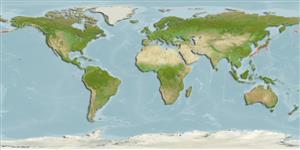>
Perciformes/Zoarcoidei (Eelpouts and pricklebacks) >
Zoarcidae (Eelpouts) > Gymnelinae
Eponymy: Dr Teodor T Nalbant (1933–2011) was a Romanian ichthyologist who worked at the Grigore Antipa National Museum of Natural History, Bucharest, which houses his collection of more than 10,000 specimens – the majority of which are of the families […] (Ref. 128868), visit book page.
More on author: Schultz.
Environment: milieu / climate zone / depth range / distribution range
Ecologia
marinhas batidemersal; intervalo de profundidade 300 - 520 m (Ref. 11954). Deep-water
North Pacific: south central Bering Sea.
Tamanho / Peso / Idade
Maturity: Lm ? range ? - ? cm
Max length : 13.5 cm SL macho/indeterminado; (Ref. 11954)
Known from 3 specimens collected in the south central Bering Sea (Ref. 11954).
Life cycle and mating behavior
Maturidade | Reprodução | Desova | Ovos | Fecundidade | Larvas
Anderson, M.E., 1994. Systematics and osteology of the Zoarcidae (Teleostei: Perciformes). Ichthyol. Bull. J.L.B. Smith Inst. Ichthyol. 60:120 p. (Ref. 11954)
Categoria na Lista Vermelha da IUCN (Ref. 130435: Version 2024-1)
Ameaça para o homem
Harmless
Utilização humana
Ferramentas
Relatórios especiais
Descarregue XML
Fontes da internet
Estimates based on models
Preferred temperature (Ref.
123201): 1.6 - 4.1, mean 3.8 °C (based on 5 cells).
Phylogenetic diversity index (Ref.
82804): PD
50 = 1.0000 [Uniqueness, from 0.5 = low to 2.0 = high].
Bayesian length-weight: a=0.00110 (0.00042 - 0.00288), b=3.09 (2.86 - 3.32), in cm total length, based on LWR estimates for this (Sub)family-body shape (Ref.
93245).
Nível Trófico (Ref.
69278): 3.2 ±0.4 se; based on size and trophs of closest relatives
Resiliência (Ref.
120179): Médio, tempo mínimo de duplicação da população 1,4 - 4,4 anos (Assuming tmax>3).
Fishing Vulnerability (Ref.
59153): Low vulnerability (10 of 100).
